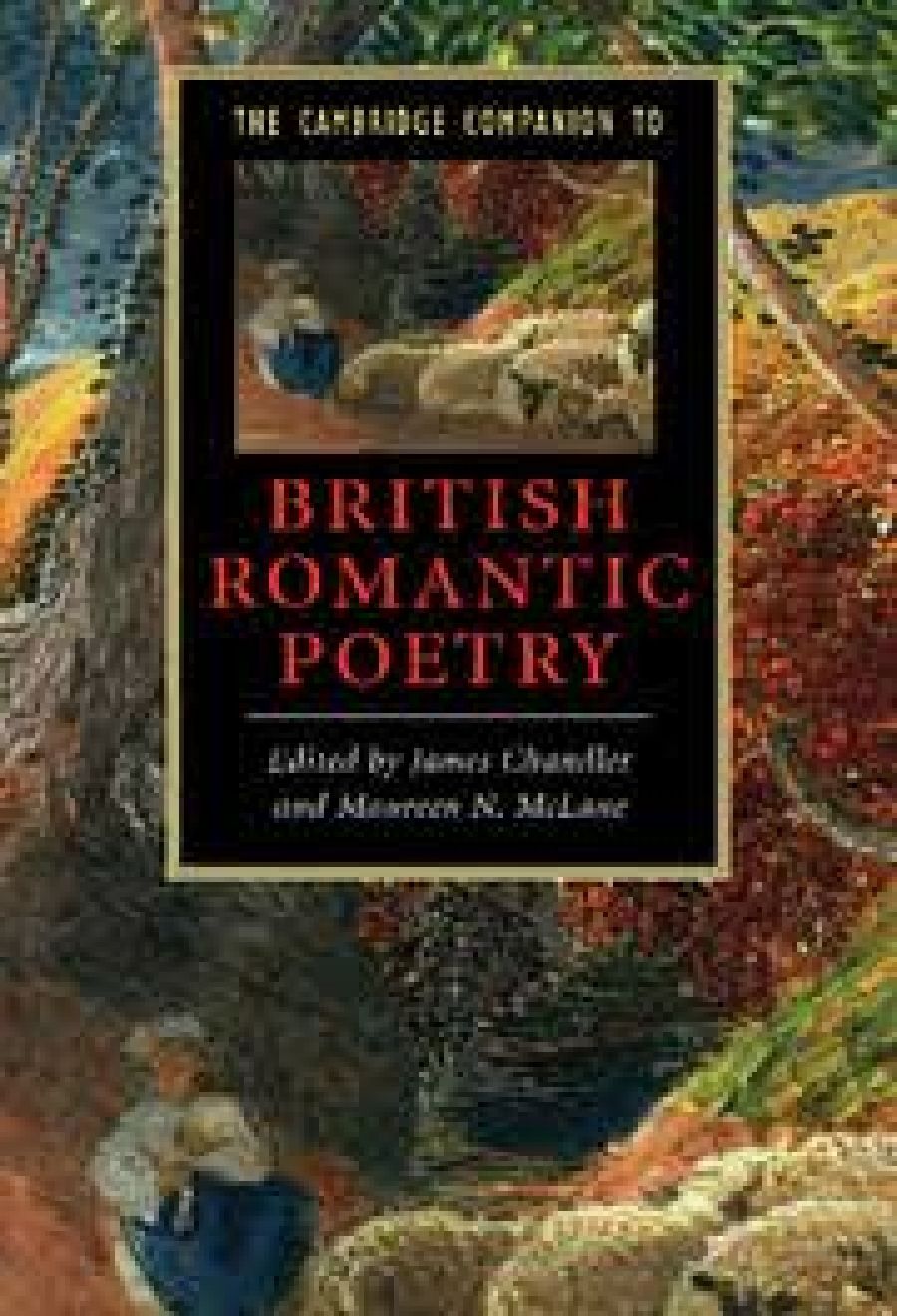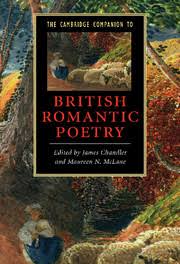
- Free Article: No
- Contents Category: Literary Studies
- Review Article: Yes
- Article Title: Electric life that burns
- Online Only: No
- Custom Highlight Text:
The Cambridge Companion series has been a very successful venture, presenting readers with handy, up-to-date collections of specially commissioned essays by leading scholars on a wide range of authors and topics. This co-edited volume on British Romantic poetry encompasses many of the key topics in Romantic literary studies of the last two decades: historicism, canonisation, antiquarianism, Gothicism, the lyric, the rise of standardised English, women’s writing, colonialism, poetry’s relationship with the novel and with philosophy, and the legacy of Romanticism in contemporary poetry. There are also several essays which, in their originality and complex argumentation, cannot be so easily summed up and labelled: a brilliant reading by James Chandler of Wordsworth’s ‘Intimations of Immortality’ Ode as an important continuation of the eighteenth century’s ‘progress of poetry’ theme; an analysis of Romantic-era poetry which argues that the study of Romantic poetry belongs as much to media history as to literary scholarship; and an essay by Kevis Goodman which, by tracking the discursive migration of nostalgia from medical discourse into the heart of Romantic aesthetics, challenges the usual clichés of this period’s poetry as a de-historicising ‘exile from the present’, a poetry of return and retreat.
- Book 1 Title: The Cambridge Companion to British Romantic Poetry
- Book 1 Biblio: CUP, $49.95 pb, 303 pp
- Book 1 Cover Small (400 x 600):

- Book 1 Cover (800 x 1200):

The volume gets off to a commanding and erudite start with Jeffrey N. Cox, who tracks the history of the construction of Romanticism by taking a snapshot of a single year, 1820. Presenting us with an all-inclusive heathen pantheon of poets as opposed to a restricted sacred canon, Cox argues that the debate in 1820 over framing what we know as Romanticism occurred within a context that included women writers, dramatists, narrative poetry and translations. The snapshot he gives us is of a huge outpouring of verse, accompanied by contemporary alarm at the overproduction of books by ‘footmen’ and ‘every superannuated governess in the island’. In addition to tracking the fierce debate underway about the status of poetry in this period, Cox surveys the immense range of poetic forms jostling for attention, displacing in the process our complacent belief that Romanticism’s major innovations were principally in the lyric form. Of the various attempts at canonisation occurring around 1820, Cox pays special attention to the activities of reviewers and writers, the latter often engaging with contemporary poetry through direct or indirect imitation, opposition and celebration. With the aim of extending our knowledge of the wider context of some of the period’s most hypercanonical poems, Cox places back in its moment of production Keats’s 1820 volume Lamia, Isabella, the Eve of St Agnes, and other Poems. Cox reminds us that the great odes of this volume struck their first readers as ‘insolent’, composed in a ‘bravado style’, judgements which make sense when the poems are read closer to the affiliations and conflicts that gave them life, namely the vogue for satirical odes.
Anxieties about a feminised literary marketplace teeming with the scribblings of superannuated governesses reappear in Adriana Craciun’s essay, ‘Romantic Poetry, Sexuality and Gender’. The vulnerability of masculine literary identities can be seen, Craciun argues, in the male poets’ impressive defences of poetry’s high cultural capital. But while poetry’s cultural capital may have been declining towards the end of the Romantic period, its readership was increasing in the widespread publication of annuals and gift books targeted at women readers. For Craciun, Romanticism, gendered female, stands at a critical historical crossroads for issues of gender and sexuality: ‘Romanticism nurtured a promiscuous proliferation of sexualities, gender identities, and forms of intimacy even as it endured an intensifying codification of complementarity.’ The faller is shorthand for ‘complementary heterosexuality, instanced in the Wordsworthian model of poetry as ‘spousal verse’, a ‘great consummation’ between poet and nature. The most original section of this essay lies in its exploration of the new literary identity of ‘the poetess’, available to both male and female poets. Tennyson’s poems in the ‘poetess’ mode – ‘Mariana’, ‘The Lady of Shalott’ and ‘The Palace of Art’ – illustrate the new selfreflexiveness and ‘queer shifts’ in the gendering of nineteenth-century poetic identities. The essay ends with reflections on spectral and unearthly lovers, mystical marriage, and the pervasive imbrication of sexual and spiritual discourses in poetry of the 1820s and 1830s, all of which serve to remind us of the central role of Gothic in any understanding of Romanticism and sexuality.
Celeste Langan and Maureen McLane, in ‘The Medium of Romantic Poetry’, bring historical media analysis to their subject. Taking their cue from Wordsworth’s 1798 Advertisement to the Lyrical Ballads, where ‘poetry’ is described as a word of ‘very disputed meaning’, they point to the persistence of oral and manuscript forms of poetry alongside print media, together with the pervasive presence of native singers, reciters, and rustic informants. The overheard voice of the solitary reaper, for instance, signals a transmediation of ‘song’ into Wordsworth’s poetic ‘numbers’. Other complex oral-literate feedback loops can be seen in Burns’s lyrics which, drawing their inspiration from oraltraditionary song, move into print but then back again into oral tradition. Now they thrive on the Internet. This striking elasticity goes hand in hand with a high level of media consciousness in poetry purportedly dedicated to the ideals of untrammelled immediacy and transparency.
The most intriguing essay in the collection is Kevis Goodman’s use of the medical discourse of ‘nostalgia’ – a term closely tied in the eighteenth century to pathologies of travel, exile, war and revolution – to reframe poetry as the ‘history or science of feelings’. Moving from medical understandings of nostalgia to Wordsworthian poetic tautology, Goodman throws new light on the ‘craving’ in the mind of ‘The Thorn’ narrator, the retired sea captain whose thoughts keep returning to the same groove. While the ‘returned mariners, failed homecomers, and closeted clinical nostalgics’ of the Lyrical Ballads might appear a mile away from the poet of The Prelude, the idea of history perceived as a ‘pathos of motion. or a certain kind of endless, unfree motion’ sheds new light (for this reader) on one of the most enigmatic passages in Wordsworth’s reflections upon the French revolution:
The horse is taught his manage, and the wind
Of heaven wheels round and treads in his own steps;
Year follows year, the tide returns again,
Day follows day, all things have second birth;
The earthquake is not satisfied at once.(The Prelude)
The final essay, by Andrew Bennell, ‘Romantic Poets and Contemporary Poetry’, returns us to the editors’ introductory claims about the conceptual force of the adjective ‘Romantic’. The word denotes not just a period but ‘a style, a movement, a way of thinking ... even a way of being in the world’, so much so that many later poets think of themselves as writing ‘in the Romantic line’. Bennett’s focus is principally on the legacy – the ‘afterlives’ – of Keats, Wordsworth, and Clare. The influence of Wordsworth on Seamus Heaney, which has been well charted, is here re-traced, but there is much that is new, too, such as the influence of Clare on John Ashbery and Derek Walcott.
Adrienne Rich has argued that ‘Poetries are no more pure and simple than human histories are pure and simple’. According to this volume’s editors, the essays they have assembled, in allowing us to glimpse the deep roots of Romantic poetry in its historical and cultural moment, suggest ‘the impure, complex riches of British Romantic poetry’. But while the essays track the ‘electric life that burns’ in the words of Shelley and his contemporaries, they also show us how Romantic poetry is ‘ever ready to be reactivated and reimagined by the latest reader’.


Comments powered by CComment